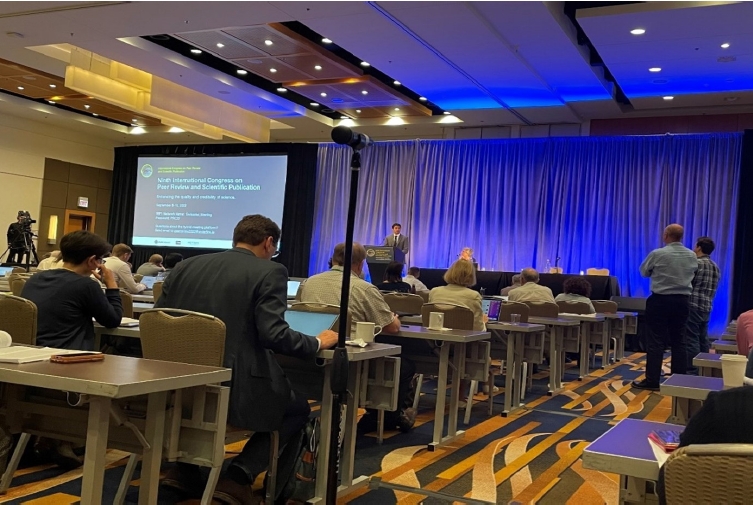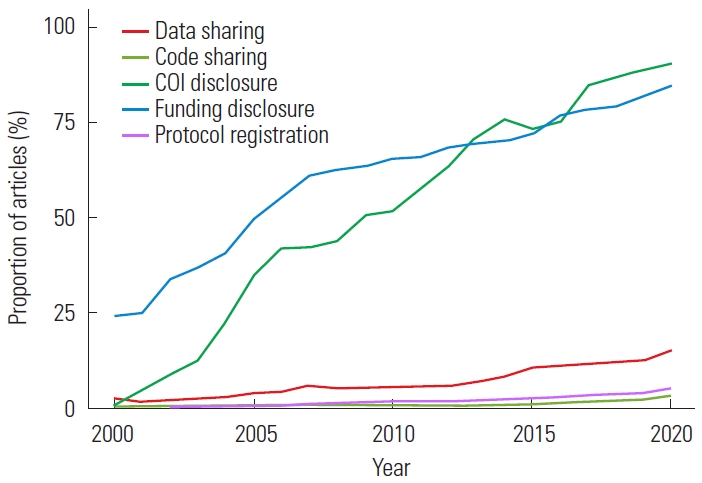Meeting: Ninth International Congress on Peer Review and Scientific Publication
Date: September 8–10, 2022
Venue: Chicago, IL, USA and online
Organizer: JAMA Network, BMJ, and Meta-Research Innovation Center at Stanford (METRICS)
The Ninth International Congress on Peer Review and Scientific Publication was held in Chicago, IL, USA from September 8 to 10, 2022. This year’s meeting was hybrid, and all plenary sessions were livestreamed for online participants. The congress has been held every 4 years since the first meeting in 1989; however, due to the COVID-19 pandemic, this year’s congress was delayed for a year. JAMA Network, BMJ, and the Meta-Research Innovation Center at Stanford (METRICS) co-hosted the conference. A total of 511 participants from 37 countries, including five invited speakers, 50 plenary lecturers, and 125 poster presenters attended. The participants were editors, publishers, researchers, funders, bibliometric and informatics experts, information innovators, librarians, journalists, policymakers, and ethicists. I attended onsite and enjoyed 3 days of the congress in Chicago (Fig. 1). The congress provided a forum for the presentation and discussion of new research on the quality and credibility of peer review and scientific publication, to establish an evidence base on which scientists can improve the conduct, reporting, and dissemination of scientific research. Onsite and online participants actively participated in every session, and the time allotted for questions and answers was very interesting.
In accordance with the aim of the congress, which was to encourage research on the quality and credibility of peer review and scientific publication, the congress provided extensive advanced information and new knowledge that could improve the conduct, reporting, and dissemination of scientific research. The program embraced a wide range of disciplines, not limited to biomedicine. As usual, the program was determined by the abstracts submitted by researchers, representing the interests and work of their scientific communities. This year’s congress had numerous excellent and worthwhile topics. Several topics of perennial interest, such as bias, editorial decision-making, research and publication ethics, reporting guidelines, peer review models, and the dissemination of scientific and scholarly information were presented. Additional topics for this year’s congress included social media and citations, as well as pandemic science. As a committee director of the Korean Association of Medical Journal Editors (KAMJE), I was particularly interested in the transparency of publication processing and peer review training.
On September 8, an invited speaker, Isabelle Boutron from France, gave the Drummond Rennie Inaugural Lecture titled “Bias, Spin, and Problems With Transparency of Research.” She is a director of Cochrane France and co-convener of the Bias Methods Group of the Cochrane Collaboration and a member of the SPIRIT-CONSORT Executive Committee. Her research focused on meta-research, methodological issues of assessing interventions, transparency, reporting guideline development, and research synthesis. She emphasized the role of the peer review process, research environment, and research ecosystem for improving transparency in scientific publications. She stated that although the percentages of articles with disclosures of conflicts of interest and funding have sharply increased compared to other indicators of transparency in the open biomedical literature (Fig. 2) [1], peer review is often biased and insufficient, and we must try to our best to reduce spin during the research and peer review processes.
The second invited lecture on the 1st day of the congress was presented by Paul Glasziou from Australia, whose topic was “Barriers to Using Research: Reducing Flawed, Inappropriate, and Poorly Reported Research.” In this lecture, he covered the broad scope of the problems of reporting guidelines, with examples including the Template for Intervention Description and Replication (TIDieR) and the use of computer-aided research. He stated that journals’ requirements to use reporting guidelines constituted an initial and important step, but the processes involved are insufficient, and a mix of additional strategies would be needed in different stages of the research process. He also mentioned that in order to improve the quality of research and reporting, the use of such tools early in research projects is very necessary.
In addition to these two impressive invited lectures, 18 plenary lectures about “Authorship, Contributorship, and Misconduct,” “Diversity, Equity, and Inclusion,” “Editorial and Peer Review Models,” and “Pandemic Science” were presented on the 1st day of the congress. Because this congress was held during the COVID-19 pandemic, many presented topics were related to COVID-19. Among them, an assessment of updates in new evidence during the rapidly evolving COVID-19 pandemic using living systematic reviews (LSRs) was presented. LSRs about COVID-19 were updated faster than those on other subjects. Thus, the rapidly evolving COVID-19 pandemic and available research could be more rapidly updated by LSRs. Other research dealt with the reliability of COVID-19–related preprints. Due to a surge in the dissemination of preprints resulting from a demand for faster and wider access to scientific knowledge about COVID-19, their preprints raised the issue of validating their results. Fortunately, the numerical results were generally similar between COVID-19 preprints and related peer-reviewed publications in the majority of randomized controlled trials.
On the 2nd day of the congress, an invited lecture entitled “Improving the Research Culture to Increase Credibility of Research Findings” was given by Brian Nosek from the United States. In this lecture, he talked about improving openness, rigor, and reproducibility in research. He said that these were less a technical challenge and more a social challenge, and that accuracy and transparency had to be sustained to improve research credibility. He addressed the importance of registered reports because they could reduce publication bias and increase rigor. He concluded that researchers and stakeholders could be doing more collaboratively to align incentives and rewards with core scholarly values to accelerate discovery and advancement of knowledge, solutions, and treatments.
The next invited speaker was Holly Falk-Krzesinski from the United States. She dealt with gender, race, and ethnicity data in editorial management systems. She emphasized the importance of sharing ethnic and gender information about researchers, editors, and reviewers to improve research integrity and reduce bias.
The other plenary abstracts—“Author and Peer Reviewer Guidance and Training,” “Peer Review,” “Dissemination of Clinical Trial Findings,” and “Grant Review and Funded Research”—followed. Ariel Lyons-Warren from the United States raised a question: “Does mentoring improve the overall quality of peer review?” She showed that peer review quality significantly improved after the completion of a formal mentored peer review program in terms of improving the critique of research methodology and suggested a more structured review process to enhance overall review quality. I thought that a structured mentoring program would be a valuable approach to expand the pool of qualified peer reviewers and could ultimately improve research integrity. A program of this type should be introduced in Korea.
On September 10, the last day of the congress, the lecture by the invited speaker Tony Ross-Hellauer from Austria was highly anticipated. He talked about “Peer Review in the Age of Open Science.” He introduced the open peer review model, which has become a central concern within the scholarly communication process. He said that the benefits of open peer review could increase accountability and transparency, avoid conflicts of interest, increase review quality, combat predatory journals, and inspect review processes. Despite concerns regarding possible higher reviewer refusal rates, increased time taken for reviews, and undesirable exposure of criticism to authors, the frequency and efficacy of open peer review have steadily increased. We need to be receptive to this challenge for shared research and enhanced transparency.
After that, other plenary abstracts were presented, such as “Data Sharing and Access,” “Preprints,” “Open Science,” “Reproducibility and Postpublication Peer Review,” and “Social Media and Citations.” I was particularly interested in the plenary abstract on preprints because this issue has recently received increasing attention in Korea. Five lectures were presented on the topic of preprints. According to the metrics of preprint submissions and posts from 2019 to 2021, preprints grew rapidly particularly for COVID-19–related research. For example, there were 913 submissions to medRxiv in 2019, 14,070 in 2020, and 12,691 in 2021, and most of the submissions were related to COVID-19. Preprint servers have grown rapidly, particularly for COVID-19–related research and active repositories for clinical and health science research. One of the lecturers who compared preprints to corresponding publications found that although a few preprints changed their main findings, most clinical studies posted as preprints and subsequently published in peer-reviewed journals had highly similar study characteristics, results, and interpretations. Further research would be needed to determine who requested those changes and why, whether these changes were associated with the quality of the study or the expertise of those requesting them, and whether changes led to increases in validity, transparency, or readability. In addition, preprints received attractive attention from media and social networking services.
The Ninth Peer Review Congress featured 3 days of presentations on new research into peer review and all aspects of scientific publication, bias, quality of reporting, and information access and dissemination. It was not limited to delivering knowledge about publication, but also addressed the expansion of ways of achieving scientific integrity in research. Overall, 125 onsite and virtual posters of original research were displayed during the congress. Participants looked around the poster hall and discussed the posters with presenters in detail. I stopped by a poster titled “Concordance between peer reviewer’s recommendations and editorial decision-making at The Journal of Pediatrics.” It was particularly interesting because it assessed the review process using the STROBE (Strengthening the Reporting of Observational Studies in Epidemiology) guidelines and showed how to improve the quality of reviews.
The congress had highly diverse topics and was very valuable for me as an editor and a researcher. During the congress, lunch was served every day as a three-course meal, not a buffet. This enabled the participants to join and interact with each other. I was able to extensively share information about the integrity of peer review in scientific publications. I would like to extend special thanks to the KAMJE for giving me the opportunity to participate in this beautiful congress.
Notes
-
Conflict of Interest
No potential conflict of interest relevant to this article was reported.
-
Funding
The work was supported by a travel grant from the Korean Association of Medical Journal Editors (KAMJE) in 2022.
Fig. 1.The Ninth International Congress on Peer Review and Scientific Publication.

Fig. 2.Indicators of transparency across the open biomedical literature on PubMed Central. COI, conflict of interest. Adapted from Serghiou et al. [1], available under the Creative Commons License.

Citations
Citations to this article as recorded by





 KCSE
KCSE

 PubReader
PubReader ePub Link
ePub Link Cite
Cite



